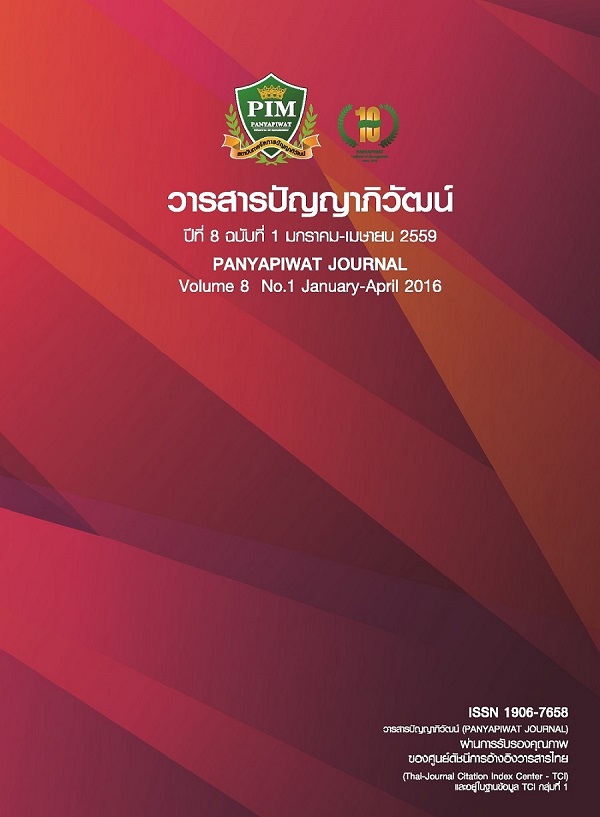แนวทางการพัฒนาการท่องเที่ยวเชิงเกษตรเศรษฐกิจสร้างสรรค์ของชุมชนบนพื้นที่สูง อำเภอแม่ริม จังหวัดเชียงใหม่: สวนกุหลาบ
Main Article Content
บทคัดย่อ
การวิจัยนี้จึงมีวัตถุประสงค์เพื่อทราบถึงแนวทางการพัฒนาการสร้างคุณค่าหรือเพิ่มมูลค่าและปัญหาข้อเสนอแนะการท่องเที่ยวเชิงเกษตรเศรษฐกิจสร้างสรรค์ เพื่อเป็นแนวทางในการปรับปรุงแก้ไขการท่องเที่ยวเชิงเกษตรชุมชนบนพื้นที่สูง อำเภอแม่ริม จังหวัดเชียงใหม่: สวนกุหลาบ โดยใช้แบบสอบถามเป็นเครื่องมือในการรวบรวมจากกลุ่มตัวอย่างโดยใช้สูตรของยามาเน่ จำนวน 400 คน ได้แก่ ประชากรในหมู่บ้านบ๋วกเตย และนักท่องเที่ยวที่เข้ามาท่องเที่ยวในชุมชน วิธีการเลือกสุ่มตัวอย่างแบบบังเอิญ ผลการวิจัย พบว่า เศรษฐกิจสร้างสรรค์เพื่อพัฒนาการท่องเที่ยวเชิงเกษตรบนพื้นที่สูง: สวนกุหลาบ อำเภอแม่ริม จังหวัดเชียงใหม่ ในภาพรวมอยู่ในระดับมาก (X = 4.20) เมื่อพิจารณาเป็นรายด้านโดยมีค่าเฉลี่ยเรียงลำดับจากมากไปหาน้อย ดังนี้ ด้านเศรษฐกิจสร้างสรรค์ (X = 3.97) ด้านความรับผิดชอบต่อสังคม สิ่งแวดล้อม (X = 3.65) และด้านการมีส่วนร่วม (X = 3.55) แนวทางการพัฒนาการท่องเที่ยวเชิงเกษตรเศรษฐกิจสร้างสรรค์ ควรมุ่งเน้น 2 ด้าน ได้แก่ 1) ด้านความรับผิดชอบต่อสังคม โดยสร้างจิตสำนึกคุณธรรมจริยธรรมจรรยาบรรณและธรรมาภิบาล และให้ความตระหนักถึงความรับผิดชอบต่อสังคมของผู้มีส่วนได้ส่วนเสียที่เกี่ยวข้องทุกๆ ฝ่าย และ 2) ส่งเสริมการสร้างประสบการณ์เชิงพื้นที่ด้วยตัวของชุมชน โดยผ่านการสื่อสารข้อมูลด้านศิลปวัฒนธรรม ประเพณี วิถีการดำเนินชีวิตที่จะส่งผลดีต่อการพัฒนาเศรษฐกิจสร้างสรรค์ของชุมชนด้วยกิจกรรมต่างๆ ในการอนุรักษ์วัฒนธรรมท้องถิ่น
This research intends to understand the guidelines for development of value creation or value added as well as to find the problem and solution for the development of Creative Agriculture Tourism of Highland community in Mae Rim District, Chiang Mai Province: rose farms. The tool to collect data of this research is questionnaire. The Yamane's formula or simplified formula is used to calculate the sample size (Yamane, 1970). Total 400 samples are the people who live in Ban Bauktoey area, Pong Yang Sub-district, Mae Rim District, Chiang Mai Province and tourists who travel to this community. From the accidental sampling or convenience sampling, the research results found out that the Creative Economy to develop Highland Agricultural Tourism: rose gardens, Mae Rim District, Chiang Mai Province in overall is in high level (X =4.20). When considering each aspect, the rank of the descending order of average are in terms of Creative Economy aspect (X =3.97), in terms of social and environmental responsibility aspect (X =3.65), and in terms of participation aspect (X =3.55). The guidelines for the development of Creative Agriculture Tourism should focus on two main aspects which are as follows. 1) In terms of social responsibility, they should form the consciousness, awareness and concentrate on recognizing the moral, ethical, code of conduct, corporate governance as well as social responsibility of all stakeholders who involved. 2) They should promote the creation of on-site experiences via the information communicate in terms of arts, cultures, traditions and lifestyle that would be beneficial to the development of Creative Economy of the community by creating local culture preserving activities.
Article Details
“ข้าพเจ้าและผู้เขียนร่วม (ถ้ามี) ขอรับรองว่า บทความที่เสนอมานี้ยังไม่เคยได้รับการตีพิมพ์และไม่ได้อยู่ระหว่างกระบวนการพิจารณาลงตีพิมพ์ในวารสารหรือแหล่งเผยแพร่อื่นใด ข้าพเจ้าและผู้เขียนร่วมยอมรับหลักเกณฑ์การพิจารณาต้นฉบับ ทั้งยินยอมให้กองบรรณาธิการมีสิทธิ์พิจารณาและตรวจแก้ต้นฉบับได้ตามที่เห็นสมควร พร้อมนี้ขอมอบลิขสิทธิ์บทความที่ได้รับการตีพิมพ์ให้แก่สถาบันการจัดการปัญญาภิวัฒน์หากมีการฟ้องร้องเรื่องการละเมิดลิขสิทธิ์เกี่ยวกับภาพ กราฟ ข้อความส่วนใดส่วนหนึ่งและ/หรือข้อคิดเห็นที่ปรากฏในบทความข้าพเจ้าและผู้เขียนร่วมยินยอมรับผิดชอบแต่เพียงฝ่ายเดียว”
เอกสารอ้างอิง
การท่องเที่ยวแห่งประเทศไทย. (2556). การท่องเที่ยวประเทศไทยภาคเหนือ. สืบค้นเมื่อ 20 มิถุนายน 2556, จาก http://www.thai.tourismthailand.org/home
ทิพย์วดี โพธิ์สิทธิพรรณ. (2556). การท่องเที่ยวเชิงสร้างสรรค์เพื่อการท่องเที่ยวอย่างยั่งยืน. วารสารวิชาการมหาวิทยาลัยฟาร์อีสเทอร์น, 6(2).
พนารัตน์ ลาภเกิน. (2553). แนวทางการพัฒนาการท่องเที่ยวเชิงอนุรักษ์ในจังหวัดสุโขทัย. สารนิพนธ์ (บรรณารักษศาสตร์และสารนิเทศศาสตร์). กรุงเทพฯ: มหาวิทยาลัยศรีนครินทรวิโรฒ.
พรรณทิมา สรรพศิรินันท์. (2552). การจัดการการสื่อสารเกี่ยวกับความรับผิดชอบต่อสังคมด้านสิ่งแวดล้อมของศูนย์การค้าครบวงจรในประเทศไทย. กรุงเทพฯ: มหาวิทยาลัยธรรมศาสตร์.
ภัทรพงษ์ เกริกสกุล, อารีย์ นัยพินิจ, ฐิรชญา มณีเนตร และธงพล พรหมสาขา ณ สกลนคร. (2557). การศึกษาศักยภาพการท่องเที่ยวเชิงศาสนาของวัดในกลุ่มจังหวัดร้อยแก่นสารสินธุ์. วารสารปัญญาภิวัฒน์, 5(1), 31-39.
รัฐนันท์ พงศ์วิริทธิ์ธร. (2556). รูปแบบทางการตลาดที่เหมาะสมกับแหล่งท่องเที่ยวถนนคนเดินเชียงใหม่. มหาวิทยาลัยเทคโนโลยีราชมงคลล้านนา.
วาทินี คุ้มแสง. (2553). ประเพณีของชาวม้ง: กรณีศึกษาชุมชนในศูนย์พัฒนาโครงการหลวงหนองหอย ต.แม่แรม อ.แม่ริม จ.เชียงใหม่. สำนักงานคณะกรรมการวิจัยแห่งชาติ (วช.). มหาวิทยาลัยราชภัฏเชียงใหม่.
สถาบันไทยพัฒน์มูลนิธิบูรณะชนบทแห่งประเทศไทย ในพระบรมราชูปถัมภ์. (2555). บรรษัทบริบาล. สืบค้นเมื่อ 30 กันยายน 2556, จาก http://sufficiencyeconomy.blogspot.com
องค์การบริหารการพัฒนาพื้นที่พิเศษเพื่อการท่องเที่ยวอย่างยั่งยืน (องค์การมหาชน). (2555). โครงการต้นแบบการท่องเที่ยวเชิงสร้างสรรค์. สืบค้นเมื่อ 30 กันยายน 2556, จาก www.dasta.or.th
องค์การบริหารส่วนตำบลโป่งแยง. (2556). ข้อมูลทั่วไปของตำบลโป่งแยง. สืบค้นเมื่อ 20 มกราคม 2556, จาก http://www.tambol.com/tambol/search_show.asp?itemno=500708
อภิสิทธิ์ ไล่สัตรูไกล. (2552). ทำไมต้องเศรษฐกิจสร้างสรรค์. กรุงเทพฯ: ศูนย์สร้างสรรค์งานออกแบบ.
Carroll, A. B. (1991). The pyramid of corporate social responsibility: Toward the moral management of organizational stakeholders. Business horizons, 34(4), 39-48.
Frederick, W., Post, J. & Davis K. (1992). Business and Society Corporate Strategy: Public Policy, Ethics. (7th ed.). New York: McGraw-Hill.
Gregory, U. & Richard, E. (2010). Growing Green: Three smart paths to developing sustainable products. Havard Business Review, 94-100.
Porter, M. E. & Kramer, M. R. (2006). Strategy and Society: The Link Between Competitive Advantage and Corporate Social Responsibility. Harvard Business Review, 84(12), 78-92.
The Best Business of a Better World. (2003). Overview of Corporate Social Responsibility. Retrieved January 16, 2014, from http://www.bsr.org/BSRResources/IssueBriefDetail.cfm?DocumentlD=48809
The Stock Exchange of Thailand. (2012). Corporate Social Responsibility Institute. Retrieved January 16, 2014, from http://www.set.or.th/setlearningcenter/files/CSRI_195.pdf
Yamane, T. (1970). Statistics: An Introductory Analysis. (3rd ed.). New York: Harper and Row.
Translated Thai References
Designated Areas for Sustainable Tourism Administration (Public Organization). (2012). Creative Tourism Thailand. Retrieved September 30, 2013, from www.dasta.or.th [in Thai]
Koomsang, V. (2010). The Traditions of The Hmong: A Case Study of the Hmong Community at The NongHoi Royal Project Development Center, Mae Ram Sub -District. Mae Rim District, Chiang Mai Province. National Research Council of Thailand. Chiang Mai Rajabhat University. [in Thai]
Kroeksakul, P., Naipinit, A., Maneenetr, T. & Promsaka Na Sakolnakorn, T. (2014). The Study Potentiality Approaches in Religion Tourism of “Roi Kaen Sarn Sin” Cluster Provinces. Panyapiwat Journal,5(1), 31-39. [in Thai]
Laisattaruklai, A. (2009). Why Creative Economy. Bangkok: Thailand Creative & Design Center. [in Thai]
Lapkern, P. (2010). Guidelines for Eco-Tourism Development of Sukhothai Province. Thesis (Library and information science). Bangkok: Srinakharinwirot. [in Thai]
Phosittipan, T. (2013). “Creative Tourism for Sustainable Tourism”. FEU Academic Review, 6(2). [in Thai]
Pongwiritthon, R. (2013). The Suitable Marketing Mix Strategy for Walking Streets in ChiangMai. Rajamangala University of Technology Lanna. [in Thai]
Pongyeang Subdistrict Administrative Organization. (2013). General Information of Pongyeang Subdistrict. Retrieved January 20, 2013, from http://www.tambol.com/tambol/search_show.asp?itemno=500708 [in Thai]
Sappasirinun, P. (2009). Communication Management on Corporate Social Responsibility in Environmental Aspect of Shopping Complex in Thailand. Bangkok: Thammasat University. [in Thai]
Thaipat Institute, Thai Rural Reconstruction Movement. (2012). Corporate Governance. Retrieved September 30, 2012, from http://sufficiencyeconomy.blogspot.com [in Thai]
Tourism Authority of Thailand. (2013). Northern of Thailand Tourism. Retrieved June 20, 2013, from http://www.thai.tourismthailand.org/home [in Thai]


